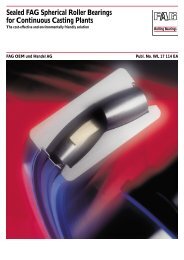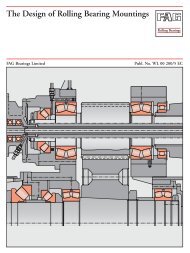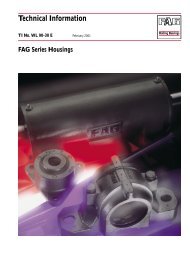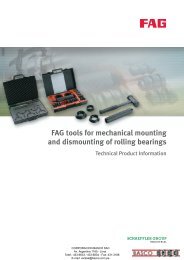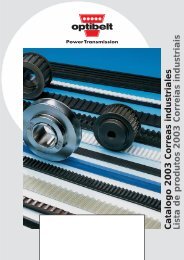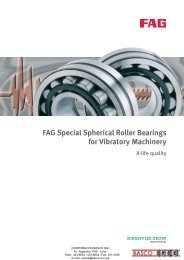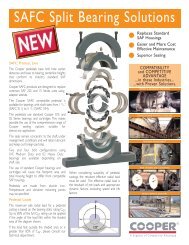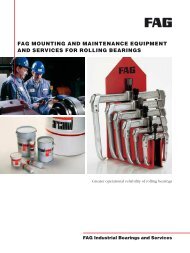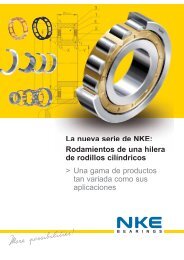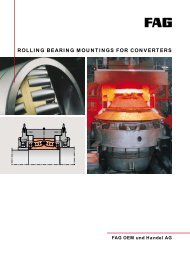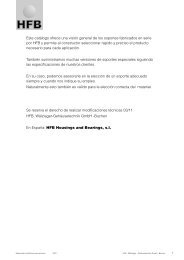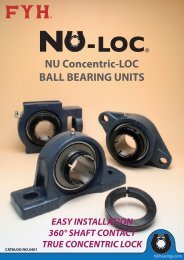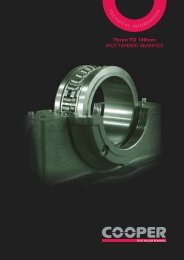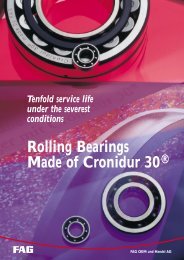- Page 1 and 2:
2009 CUSTOM CLASSICS CATALOG
- Page 3 and 4:
CONTENTS REEVES ULTIMA REEVES MOTOD
- Page 5 and 6:
INTRODUCTION REEVES ULTIMA ULTIMA R
- Page 7 and 8:
INTRODUCTION REEVES ULTIMA ULTIMA R
- Page 9 and 10:
FEATURES/BENEFITS DODGE APG America
- Page 11 and 12:
Introduction DODGE APG SPECIFICATIO
- Page 13 and 14:
NOMENCLATURE Introduction APG Reduc
- Page 15 and 16:
SELECTION Introduction DODGE APG MA
- Page 17 and 18:
SELECTION Introduction DODGE APG MA
- Page 19 and 20:
Introduction DODGE APG MASTER XL SE
- Page 21 and 22:
SELECTION Introduction DODGE APG MA
- Page 23 and 24:
SELECTION Introduction DODGE APG MA
- Page 25 and 26:
SELECTION Introduction DODGE APG MA
- Page 27 and 28:
SELECTION Introduction DODGE APG MA
- Page 29 and 30:
SELECTION Introduction DODGE APG AP
- Page 31 and 32:
SELECTION Introduction DODGE APG AP
- Page 33 and 34:
SELECTION DODGE Combination TIGER M
- Page 35 and 36:
DODGE Combination TIGER MASTER XL D
- Page 37 and 38:
DODGE Combination TIGER MASTER XL D
- Page 39 and 40:
REEVES MOTODRIVE DODGE Combination
- Page 41 and 42:
REEVES MOTODRIVE DODGE Combination
- Page 43 and 44:
REEVES MOTODRIVE DODGE Combination
- Page 45 and 46:
REEVES MOTODRIVE DODGE Combination
- Page 47 and 48:
REEVES MOTODRIVE DODGE Combination
- Page 49 and 50:
REEVES MOTODRIVE DODGE Combination
- Page 51 and 52: REEVES MOTODRIVE DODGE Combination
- Page 53 and 54: REEVES MOTODRIVE DODGE Combination
- Page 55 and 56: REEVES MOTODRIVE DODGE Combination
- Page 57 and 58: Introduction DIMENSIONS APG Gearmot
- Page 59 and 60: Introduction DIMENSIONS APG Gearmot
- Page 61 and 62: REEVES ULTIMA REEVES MOTODRIVE DODG
- Page 63 and 64: DIMENSIONS Introduction APG Gearmot
- Page 65 and 66: Introduction DIMENSIONS APG Gearmot
- Page 67 and 68: Introduction DIMENSIONS APG C-Face
- Page 69 and 70: Introduction DIMENSIONS APG C-Face
- Page 71 and 72: Introduction DIMENSIONS APG C-Face
- Page 73 and 74: Introduction DIMENSIONS APG C-Face
- Page 75 and 76: Introduction DIMENSIONS APG C-Face
- Page 77 and 78: Introduction DIMENSIONS APG C- Face
- Page 79 and 80: Introduction DIMENSIONS APG C-Face
- Page 81 and 82: Introduction DIMENSIONS APG Separat
- Page 83 and 84: Introduction DIMENSIONS APG Separat
- Page 85 and 86: Introduction MOUNTING POSITIONS APG
- Page 87 and 88: Introduction MOUNTING POSITIONS APG
- Page 89 and 90: Introduction DODGE APG ENGINEERING/
- Page 91 and 92: REEVES ULTIMA REEVES MOTODRIVE DODG
- Page 93 and 94: Introduction DODGE APG ENGINEERING/
- Page 95 and 96: Introduction DODGE APG MASTER XL EN
- Page 97 and 98: FEATURES/BENEFITS MASTER ® Introdu
- Page 99 and 100: Introduction DODG APG SPECIFICATION
- Page 101: Introduction HOW TO ORDER MASTER ®
- Page 105 and 106: NOMENCLATURE MASTER ® Introduction
- Page 107 and 108: SELECTION MASTER ® Introduction XL
- Page 109 and 110: REEVES MOTODRIVE DODGE Combination
- Page 111 and 112: SELECTION MASTER ® Introduction DO
- Page 113 and 114: SELECTION MASTER ® REEVES MOTODRIV
- Page 115 and 116: SELECTION MASTER ® Introduction XL
- Page 117 and 118: DODGE Combination TIGER MASTER XL D
- Page 119 and 120: REEVES MOTODRIVE DODGE Combination
- Page 121 and 122: REEVES MOTODRIVE DODGE Combination
- Page 123 and 124: Introduction DODGE APG MASTER XL SE
- Page 125 and 126: Introduction DODGE APG MASTER XL SE
- Page 127 and 128: Introduction DODGE APG MASTER XL SE
- Page 129 and 130: Introduction DODGE APG MASTER XL SE
- Page 131 and 132: MASTER ® DIMENSIONS XL Right Angle
- Page 133 and 134: MASTER ® DIMENSIONS XL Right Angle
- Page 135 and 136: MASTER ® DIMENSIONS XL Right Angle
- Page 137 and 138: MASTER ® XL Right Angle Reducers-
- Page 139 and 140: MASTER ® XL Right Angle Reducers-
- Page 141 and 142: MASTER ® XL Right Angle Reducers -
- Page 143 and 144: MASTER ® XL Right Angle Reducers S
- Page 145 and 146: MASTER ® XL Right Angle Reducers S
- Page 147 and 148: MASTER ® XL Right Angle Reducers -
- Page 149 and 150: MASTER ® XL Right Angle Reducers -
- Page 151 and 152: MASTER ® XL Right Angle Reducers -
- Page 153 and 154:
MASTER ® XL Right Angle Gearmotors
- Page 155 and 156:
MASTER ® XL Right Angle Gearmotors
- Page 157 and 158:
MASTER ® XL Right Angle Gearmotors
- Page 159 and 160:
MASTER ® XL Right Angle Gearmotors
- Page 161 and 162:
MASTER ® XL Parallel - Size 16 DOU
- Page 163 and 164:
MASTER ® XL Parallel - Size 21 Sin
- Page 165 and 166:
MASTER ® XL Parallel - Size 21 tri
- Page 167 and 168:
MASTER ® XL Parallel - Size 28 DOU
- Page 169 and 170:
MASTER ® XL Parallel - 1/3 HP AGMa
- Page 171 and 172:
MASTER ® XL Parallel - 3/4 HP agma
- Page 173 and 174:
MASTER ® XL Parallel - 1-1/2 HP AG
- Page 175 and 176:
MASTER ® XL Parallel - 3 HP AGMA C
- Page 177 and 178:
MASTER ® XL Parallel - 7.5 HP AGMA
- Page 179 and 180:
MASTER ® Integral Gearmotor Dimens
- Page 181 and 182:
MASTER ® Integral Gearmotor Dimens
- Page 183 and 184:
MASTER ® XL Parallel Reducers FLAN
- Page 185 and 186:
MOUNTING POSITIONS MASTER ® Introd
- Page 187 and 188:
Introduction DODGE APG MASTER XL EN
- Page 189 and 190:
Introduction DODGE APG MASTER XL IN
- Page 191 and 192:
Introduction FEATURES/BENEFITS DODG
- Page 193 and 194:
REEVES ULTIMA REEVES MOTODRIVE DODG
- Page 195 and 196:
DODGE Combination TIGER MASTER XL D
- Page 197 and 198:
DODGE Combination TIGER MASTER XL D
- Page 199 and 200:
DODGE Combination TIGER MASTER XL D
- Page 201 and 202:
Introduction SELECTION Combination
- Page 203 and 204:
REEVES MOTODRIVE DODGE Combination
- Page 205 and 206:
REEVES MOTODRIVE DODGE Combination
- Page 207 and 208:
REEVES MOTODRIVE DODGE Combination
- Page 209 and 210:
Introduction SELECTION Combination
- Page 211 and 212:
REEVES MOTODRIVE DODGE Combination
- Page 213 and 214:
DIMENSIONS / MOUNTING POSITIONS Int
- Page 215 and 216:
DIMENSIONS / MOUNTING POSITIONS Int
- Page 217 and 218:
Introduction DDGE APG DIMENSIONS /
- Page 219 and 220:
DIMENSIONS / MOUNTING POSITIONS Int
- Page 221 and 222:
Introduction MOUNTING POSITIONS Com
- Page 223 and 224:
Introduction DODGE APG MODIFICATION
- Page 225 and 226:
Introduction DODGE APG MASTER XL MO
- Page 227 and 228:
Introduction DODGE APG MASTER XL MO
- Page 229 and 230:
Introduction MODIFICATIONS / ACCESS
- Page 231 and 232:
MODIFICATIONS / ACCESSORIES Introdu
- Page 233 and 234:
MODIFICATIONS / ACCESSORIES Introdu
- Page 235 and 236:
REEVES ULTIMA REEVES MOTODRIVE DODG
- Page 237 and 238:
REEVES ULTIMA REEVES MOTODRIVE DODG
- Page 239 and 240:
REEVES ULTIMA REEVES MOTODRIVE DODG
- Page 241 and 242:
REEVES ULTIMA REEVES MOTODRIVE DODG
- Page 243 and 244:
Introduction ENGINEERING / TECHNICA
- Page 245 and 246:
REEVES ULTIMA REEVES MOTODRIVE DODG
- Page 247 and 248:
NOTES REEVES ULTIMA REEVES MOTODRIV
- Page 249 and 250:
Introduction FEATURES/BENEFITS MOTO
- Page 251 and 252:
Introduction DODGE APG SPECIFICATIO
- Page 253 and 254:
REEVES MOTODRIVE DODGE Combination
- Page 255 and 256:
REEVES ULTIMA REEVES MOTODRIVE DODG
- Page 257 and 258:
REEVES ULTIMA REEVES MOTODRIVE DODG
- Page 259 and 260:
REEVES ULTIMA REEVES MOTODRIVE DODG
- Page 261 and 262:
REEVES MOTODRIVE DODGE Combination
- Page 263 and 264:
REEVES MOTODRIVE DODGE Combination
- Page 265 and 266:
DODGE Combination TIGER MASTER XL D
- Page 267 and 268:
REEVES MOTODRIVE DODGE Combination
- Page 269 and 270:
REEVES MOTODRIVE DODGE Combination
- Page 271 and 272:
REEVES MOTODRIVE DODGE Combination
- Page 273 and 274:
DODGE Combination TIGER MASTER XL D
- Page 275 and 276:
Introduction DODGE APG MASTER XL SE
- Page 277 and 278:
Introduction DIMENSIONS MOTODRIVE -
- Page 279 and 280:
Introduction DIMENSIONS MOTODRIVE -
- Page 281 and 282:
Introduction DIMENSIONS MOTODRIVE -
- Page 283 and 284:
Introduction DIMENSIONS MOTODRIVE -
- Page 285 and 286:
Introduction DIMENSIONS MOTODRIVE -
- Page 287 and 288:
Introduction DIMENSIONS MOTODRIVE -
- Page 289 and 290:
Introduction DIMENSIONS MOTODRIVE -
- Page 291 and 292:
Introduction DIMENSIONS MOTODRIVE -
- Page 293 and 294:
Introduction DIMENSIONS MOTODRIVE -
- Page 295 and 296:
Introduction DIMENSIONS MOTODRIVE -
- Page 297 and 298:
Introduction DIMENSIONS MOTODRIVE -
- Page 299 and 300:
Introduction DIMENSIONS MOTODRIVE -
- Page 301 and 302:
Introduction DIMENSIONS MOTODRIVE -
- Page 303 and 304:
Introduction DODGE APG MODIFICATION
- Page 305 and 306:
MODIFICATIONS REEVES Introduction D
- Page 307 and 308:
Introduction DIMENSIONS REEVES MOTO
- Page 309 and 310:
Introduction DIMENSIONS MOTODRIVE -
- Page 311 and 312:
DIMENSIONS REEVES Introduction MOTO
- Page 313 and 314:
Introduction DIMENSIONS MOTODRIVE -
- Page 315 and 316:
Introduction DIMENSIONS MOTODRIVE -
- Page 317 and 318:
Introduction DODGE APG MASTER XL EN
- Page 319 and 320:
Introduction DODGE APG MASTER XL EN
- Page 321 and 322:
REEVES ULTIMA REEVES MOTODRIVE DODG
- Page 323 and 324:
Introduction ENGINEERING/TECHNICAL
- Page 325 and 326:
FEATURES/BENEFITS REEVES Introducti
- Page 327 and 328:
Introduction DODGE APG SPECIFICATIO
- Page 329 and 330:
Introduction DODGE APG MASTER XL SE
- Page 331 and 332:
Introduction DODGE APG MASTER XL SE
- Page 333 and 334:
Introduction DODGE APG MASTER XL SE
- Page 335 and 336:
Introduction SELECTION ULTIMA - Par
- Page 337 and 338:
Introduction DIMENSIONS ULTIMA - Pa
- Page 339 and 340:
Introduction DIMENSIONS ULTIMA - Pa
- Page 341 and 342:
Introduction DIMENSIONS ULTIMA - Pa
- Page 343 and 344:
Introduction MOUNTING POSITIONS ULT
- Page 345 and 346:
Introduction DODGE APG MASTER XL SE
- Page 347 and 348:
Introduction DODGE APG MASTER XL SE
- Page 349 and 350:
Introduction DIMENSIONS ULTIMA - Ri
- Page 351 and 352:
MOUNTING POSITIONS REEVES Introduct
- Page 353 and 354:
Introduction SELECTION ULTIMA - NEM
- Page 355 and 356:
Introduction DIMENSIONS ULTIMA - NE
- Page 357 and 358:
REEVES ULTIMA REEVES MOTODRIVE DODG
- Page 359 and 360:
REEVES MOTODRIVE DODGE Combination
- Page 361 and 362:
REEVES MOTODRIVE DODGE Combination
- Page 363 and 364:
REEVES MOTODRIVE DODGE Combination
- Page 365 and 366:
REEVES MOTODRIVE DODGE Combination
- Page 367 and 368:
RENEWAL PARTS REEVES Introduction U
- Page 369 and 370:
REEVES MOTODRIVE DODGE Combination
- Page 371 and 372:
REEVES Pulleys FEATURES/BENEFITS RE
- Page 373 and 374:
SELECTION REEVES REEVES Pulleys REE
- Page 375 and 376:
REEVES Pulleys Part Number Index SE
- Page 377 and 378:
REEVES Pulleys SELECTION REEVES Jun
- Page 379 and 380:
REEVES Pulleys Part Number Index SE
- Page 381 and 382:
REEVES Pulleys Part Number Index SE
- Page 383 and 384:
NOTES Part Number Index REEVES Pull
- Page 385 and 386:
PART NUMBER INDEX REEVES Pulleys Pa
- Page 387 and 388:
PART NUMBER INDEX REEVES Pulleys Pa
- Page 389 and 390:
PART NUMBER INDEX REEVES Pulleys Pa
- Page 391 and 392:
PART NUMBER INDEX REEVES Pulleys Pa
- Page 393 and 394:
PART NUMBER INDEX REEVES Pulleys Pa
- Page 395 and 396:
PART NUMBER INDEX REEVES Pulleys Pa
- Page 397 and 398:
PART NUMBER INDEX REEVES Pulleys Pa
- Page 399 and 400:
PART NUMBER INDEX REEVES Pulleys Pa
- Page 401 and 402:
PART NUMBER INDEX REEVES Pulleys Pa
- Page 403 and 404:
NOTES Part Number Index REEVES Pull



